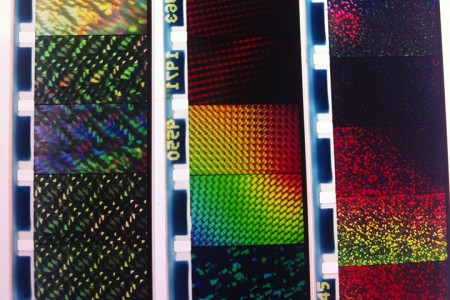
Could you tell us a little bit about the program you’ll be screening for Conversations at the Edge this fall?
Sure. The formal description:
Let Your Light Shine investigates the formal principles of abstract cinema while maturing an interest in found materials; evolving modes of production and labor; and the role of decoration in daily life. Prodding at hierarchies of aesthetic value and the tension between high and low, these works question the role of abstract animation in a post-psychedelic climate. Merch tables meet museum gift stores. The sublime meets Sublime the band. Ebullient spectacles surface from resurrected dead capital and banal everyday objects. Stroboscopic eulogies celebrate the spectrum of abstraction from transcendent visual experiences to science kit optical fascinations, forcing a proscenium collision of the arena rock show, the planetarium light performance, and the cinema.
The casual description:
One piece is a rock opera documentary about a dying pop-culture merch business. I will narrate this live via song. Another piece requires viewing through prismatic glasses that turn each image into seven rainbows. There may or may not be a special surprise and/or a costume contest.
What inspires you in the world?
Mostly I’m inspired by why the majority of normal people despise contemporary art and how imagery oscillates between worlds of obscurist and mainstream consumption. I’m also inspired by how technology simultaneously enhances and ruins the world.

Tell us a bit about your process: how do you start a piece, and how do you know when it’s finished.
Films usually start when I find or inherit a large collection of objects in multiples. If I move or someone else moves, for example, a film usually comes to life. The constraints of working with a 16mm Bolex camera often determine durational/logistical structures for my films. For a while, I only wanted to make one-roll pieces (4,000 frames, 2m45s). Then, this year, I began extending the length of my material studies (but still allowing the roll structure to determine the length, growing to 3 or 4 rolls instead of one). Part of the beauty of working on film is that the animation process is kind of like a performance. Sometimes people skip beats or hit the wrong notes, and that’s the way it goes. Most of my 16mm films are shot in-camera, so what I shoot is what I get.
What artists are you following right now?
Sorry, I’m not on Twitter.
JK. Wow! A great question (a hard one, too, because one of the best things about being an artist is getting to know and love many other artists!!!) A quick, alphabetical-and-equally-gendered sampling: Eliza Fernand, Paul Glabicki, Leif Goldberg, Stefan Gruber, Jesse McLean, Kelly Sears, Stacey Steers, Guy Sherwin, Miwa Matreyek, Mirai Mizue, Xander Marro, Shana Moulton, Michael Robinson, Jonathan Schwartz.
What are you most looking forward to about presenting this new body of work?
I’m mostly excited that this is the first “body of work” I’ve created to actually be a “body of work”. These films were made to go together. Threads join, separate, and recur throughout the program. In the past showing programs of my work, I’ve always feared it was sort of half and half of one thing or another, but this program feels completely cohesive. It represents a year where my practice grew in leaps and bounds. I am taking risks, stretching myself, and demonstrating range. I see this program of a culmination of any of the ideas and themes we’ve seen swimming in my work for years. It’s time to serve the stew that’s been simmering. Mmmm, fall!
I hope this group of films proves that, at least for now, I’m committed to continually finding and renewing my voice as an animator.